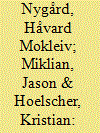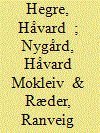|
|
|
Sort Order |
|
|
|
Items / Page
|
|
|
|
|
|
|
| Srl | Item |
| 1 |
ID:
152230


|
|
|
|
|
| Summary/Abstract |
Do elections reduce or increase the risk of autocratic regime breakdown? This article addresses this contested question by distinguishing between election events and the institution of elections. The authors propose that elections stabilize autocracies in the long term but at the price of short-term instability. Elections are conducive to regime survival in the long run because they improve capacities for co-optation and repression but produce short-term instability because they serve as focal points for regime opposition. Drawing on data from 259 autocracies from 1946 to 2008, the authors show that elections increase the short-term probability of regime failure. The estimated effect is retained when accounting for the endogeneity of autocratic elections; this finding is critical, since some autocrats may or may not hold elections because of perceived effects on regime survival. The authors also find that this destabilizing effect does not operate in the long term. They find some, although not as strong, evidence that elections stabilize autocratic regimes in the medium to long term, despite their destabilizing immediate effects. These temporal effect patterns are present for both executive and legislative elections, and they are robust to using different measures, control variable strategies, and estimation techniques. In line with expectations, both effect patterns are much clearer for multiparty autocratic elections than for completely uncontested elections.
|
|
|
|
|
|
|
|
|
|
|
|
|
|
|
|
| 2 |
ID:
153691


|
|
|
|
|
| Summary/Abstract |
What factors explain attacks on humanitarian aid workers? Most research has tended to describe trends rather than analyse the underlying reasons behind attacks. To move this agenda forward, we present to our knowledge the first peer-reviewed cross-national time-series study that identifies factors related to violent attacks on humanitarian aid workers. Our theoretical framework explores two sets of potential explanatory factors: dynamics of conflicts; and the politicization and militarization of humanitarian operations. Using a global sample at the country level from 1997 to 2014, our results suggest that: (i) the presence and severity of armed conflicts are related to increased attacks on aid workers; (ii) aid workers do not appear to face greater risks even where civilians are targeted; (iii) the presence of an international military force does not appear to add to nor decrease risks to aid workers; and (iv) the effects of peacekeeping operations upon humanitarian security are varied. We discuss this in light of the ongoing challenges facing humanitarian organizations to provide security in fragile and conflict-affected areas.
|
|
|
|
|
|
|
|
|
|
|
|
|
|
|
|
| 3 |
ID:
152301


|
|
|
|
|
| Summary/Abstract |
Several studies show that internal armed conflict breeds conflict by exacerbating conditions that increase the chances of war breaking out again. Empirically, this ‘conflict trap’ works through four pathways: conflicts increase the likelihood of continuation, recurrence, escalation, and diffusion of conflict. Past empirical studies have underestimated the scope and intensity of the conflict trap since they consider the impact of conflict only through one of these pathways and rarely across sufficiently long time periods. This article shows that simulation and forecasting techniques are useful and indeed necessary to quantify the total, aggregated effect of the conflict trap, over long time periods and across countries. We develop a country-year statistical model that allows estimating the probability of no conflict, minor conflict, and major conflict, and the probabilities of transition between these states. A set of variables denoting the immediate and more distant conflict history of the country are used as endogenous predictors in the simulated forecasts. Another set of variables shown to be robustly associated with armed conflict are treated as exogenous predictors. We show that the conflict trap is even more severe than earlier studies have indicated. For instance, if a large low-income country with no previous conflicts is simulated to have two to three years of conflict over the 2015–18 period, we find that it will have nine more years of conflict over the 2019–40 period than if peace holds up to 2018. Conversely, if a large low-income country that has had major conflict with more than 1,000 battle-related deaths in several of the past ten years succeeds in containing violence to minor conflict over the 2015–18 period, we find that it will experience five fewer years of conflict in the subsequent 20 years than if violence continues unabated.
|
|
|
|
|
|
|
|
|
|
|
|
|
|
|
|
|
|
|
|
|